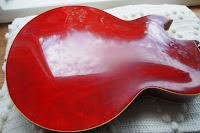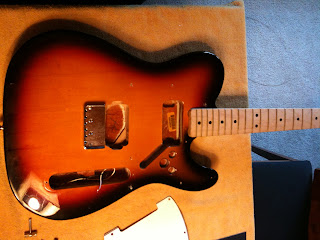I knew this guitar was special the moment I saw it... a weirdly modded vintage Gibson hollowbody. The last three words of the sentence will make most guitar guys lick their chops. Anyway, this one made it onto the bench a while ago in the condition you see below: humbucker at the bridge, single coil (in humbucker sized mounting ring) at the neck, newer tuners and bridge. The best part about this one is that the original hardware was all still with the guitar. Tuners, bridge, case, and most importantly, those original P-90's. The main idea was to bring this back in to proper Gibson form (sound-wise) while making sure it will be reliable as a gigging instrument. Besides that, it just looks cool.

Any good student of Gibson hollowbodies is already throwing their hands up at this post screaming "You idiot you have the model number wrong!! That guitar with two pickups would be a TDC, not a TC you moron!" I say to that person "Don't be a dick, just hang on a minute..." You see that person is actually right, Gibson had a suffix at the end of the model number for these guitars and each letter stands for a different, optional feature...
T = Thinline (more like a 335 than a 175)
C = Cutaway (instead of full, acoustic guitar shape)
D = Dual pickups (instead of only a neck pickup)
This guitar is clearly stamped ES125TC inside the upper sound hole sooooo... the bridge pickup route, bridge volume and tone, and the 3-way switch are not original. There are two older P-90's in the case though... So lets get crackin'...
 The existing pickups actually sounded really good and the setup suited this guitar well but, none-the-less they do not belong. I grabbed the trusty screwdriver and removed the neck pickup mount but wait... no screws at the bridge mount? What the... is that... hot glue? Yep. I dunno... I grabbed the X-Acto and began whittling away at the clear glue. I was very careful not to pull any of the finish away and to remove as much of the glue as possible. Once the pickups were both free I was able to see that the last modifier of this guitar was smart enough to splice the pickup leads in place so I did not have to remove the pots, input jack and ground wire. This would have taken four times as long had it not been for that.
The existing pickups actually sounded really good and the setup suited this guitar well but, none-the-less they do not belong. I grabbed the trusty screwdriver and removed the neck pickup mount but wait... no screws at the bridge mount? What the... is that... hot glue? Yep. I dunno... I grabbed the X-Acto and began whittling away at the clear glue. I was very careful not to pull any of the finish away and to remove as much of the glue as possible. Once the pickups were both free I was able to see that the last modifier of this guitar was smart enough to splice the pickup leads in place so I did not have to remove the pots, input jack and ground wire. This would have taken four times as long had it not been for that.  With the strings off and the pickups out I could clean the body and hardware more easily. The tuners are newer and will probably be more reliable than the connected, three-on-a-side original tuners. I elected to keep them on the guitar. In the late 60's Gibson used ABR-1 style bridges with threaded posts on these guitars instead of the archtop style bridges of years past. I do not know why. Since the posts were replaced as well as the bridge, the original does not fit very well on the replacements. I elected to keep it off for the time being but it will eventually make its way back on this guitar.
With the strings off and the pickups out I could clean the body and hardware more easily. The tuners are newer and will probably be more reliable than the connected, three-on-a-side original tuners. I elected to keep them on the guitar. In the late 60's Gibson used ABR-1 style bridges with threaded posts on these guitars instead of the archtop style bridges of years past. I do not know why. Since the posts were replaced as well as the bridge, the original does not fit very well on the replacements. I elected to keep it off for the time being but it will eventually make its way back on this guitar.  |
| Always use protection. |
 |
| Connections at mid-wire. |

The pickups each have a slightly different color base-plate. The darker base-plate with the slotted mounting holes fit perfectly at the neck position so I assumed this was its original home. The other pickup had a lighter color base-plate and round mounting holes. It fit fine in the existing humbucker-sized rout at the bridge. The next step was to slap on the original chrome P-90 covers. Damn... the bridge cover is too tall and the strings almost make contact with it. In fact, the pole pieces nearly touch the strings... Time for pickup surgery...
 |
| What it should look like. |
 |
| Pickup cover too tall |
After removing the two phillips screws and the baseplate I am presented with the original spruce spacers. Gibson used various thicknesses of spruce to set the pickup height relative to the strings. Crude, but it works. In this situation, the proper height was achieved by removing the wood completely. The pickups would sound most balanced this way. When I went to re-assemble the pickup, the longer screws (without the spacer) now would not tighten down completely. The base-plate was rattling around and the bobbin was not secure. I have a hard-learned rule to never force a screw that does not want to move so I backed these out and had a beer to think it over. That's when the serendipity kicks in... I remember an old parts chest my grandpa gave me full of small metal things and old screws from the middle of the 20th century. It took all of two minutes to find two identical screws. I ground down the ends of these with a Dremel (something I would never do to vintage Gibson hardware) and they fit perfectly in the old pickup. Now the pickup will set correctly and the original screws and spruce spacers are safely tucked away with the other original parts.




 |
| Each original screw is on the left. |
 Now all that left is to wire it up, set it up and rock out like George Thorogood. And wow, that old Gibson sound is in there! Crank the amp and hold your ears... my wife had to leave... The guitar plays great, sound even better, and is ready to rock for another 40+ years. And all those original parts and pieces are still in the case pocket. Win, Win... Win.
Now all that left is to wire it up, set it up and rock out like George Thorogood. And wow, that old Gibson sound is in there! Crank the amp and hold your ears... my wife had to leave... The guitar plays great, sound even better, and is ready to rock for another 40+ years. And all those original parts and pieces are still in the case pocket. Win, Win... Win.Now does anyone know where I can find P-90 covers with arched bottoms?
 |
| Original Bridge. |
 |
| Original Tuners. |
 |
| Here she is today |
 |
| Close Up |





































